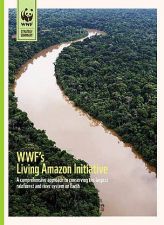Pedro Bara Neto, head of the Free Flowing Rivers & Forest Friendly Roads strategy of WWF’s Living Amazon Initiative, says the big hydro-expansion plan for the Amazon Basin, will have a very severe impact on communities, habit and species. Far better, he argues, would be to diversify into renewable energies, which will be less vulnerable to climate change and generate many more permanent jobs.
LATIN AMERICA BUREAU: Could you tell us what kind of network of hydroelectric power stations is planned for the Amazon Basin?
 Pedro Bara Neto: In most Amazon countries what is planned is to advance the hydropower frontier into the Amazon, which represents the bulk of the energy potential still to be exploited in South America. In Brazil, for instance, for the remaining 180GW of hydropower, two thirds are located in Amazon Rivers. Similar or even higher relevance is also true for Bolivia, Ecuador, Guyana and Peru.
Pedro Bara Neto: In most Amazon countries what is planned is to advance the hydropower frontier into the Amazon, which represents the bulk of the energy potential still to be exploited in South America. In Brazil, for instance, for the remaining 180GW of hydropower, two thirds are located in Amazon Rivers. Similar or even higher relevance is also true for Bolivia, Ecuador, Guyana and Peru.
LAB: Who will benefit from the energy?
PBN: The energy is for the national interconnected system. In this context it will also require expansion of the national transmission across the Amazon.
LAB: What will the impact be on biodiversity?
PBN: Given the scale of the intervention, over 150 large dams, the impact on hydrological connectivity and therefore on fragmentation of rivers and aquatic ecosystems will be very severe, with unprecedented consequences to the aquatic biodiversity. Moreover, the cumulative impact on the natural system pulse will strongly impact habitat, species and communities that depend on the region nature’s cycles.
LAB: Scientists believe that the (relatively) intact Amazon forest plays an important role in stabilizing the global climate. Will these power stations, directly or indirectly, affect this role that the forest plays?
PBN: There is clear evidence that indirect impacts from two large hydropower stations being built along the Madeira River, Santo Antonio and Jirau, have already caused increasing deforestation rates in the state of Rondonia, Brazil. This scenario will be much worse in the emerging hydropower programme for the Tapajós River basin, which is still relatively preserved (about 80% of its 50 million hectares still has its original coverage). The direct impact of this programme of over 40 dams will be the flooding of almost 1 million hectares of forest, with 3 out of 4 projects affecting either a protected area or an indigenous territory. The indirect impact of this huge investment (over US$ 60billion) is not yet known.
LAB: The International Energy Agency (IEA) recently said that it is ‘almost inevitable’ that the world experiences global warming of 2 degrees C and that the planet is still on course for much higher warming. Scientists from INPA say that the Amazon forest is already being affected by global warming. Although no one quite knows what the impact will be on the forest, might such warming affect the long term viability of the power stations?
PBN: Yes, definitely. In order to mitigate the direct impact of flooded areas most of the power stations in the Amazon are designed as “run-of-the-river” projects with relatively smaller reservoirs. This is good for the local environment, but bad for the project efficiency and energy security of the national system. The more run-of-the-river projects are built in the Amazon, the more vulnerable the electrical energy national interconnected system will be to climate change.
LAB: Presidents Lula and Dilma Rousseff have repeatedly said that Brazil needs to exploit its natural resources to lift its population out of poverty and that massive hydroelectric power is needed for this. How do you respond?
PBN: In the last years there was a clear process of social mobility, with millions of Brazilians moving above the poverty line. With the international crisis and the lack of structural changes in Brazil’s economy, there is a general understanding that this process has lost its momentum. Nevertheless, Brazil will definitely need to expand its energy supply, but this does not have to come from massive hydroelectric power. On the contrary, in the light of climate change and considering the limitations of hydropower development in the Amazon, Brazil has to diversify its energy matrix by promoting more modern renewable alternatives such as wind and solar power, along with biomass from sugar cane. This gradual diversification, which does not mean getting rid of hydropower development, at least in the mid-term, will be also very healthy for the economy, since it will promote green jobs which will be much more durable than the cyclical construction ones and will be associated with more modern and globally relevant industries rather than the old heavy construction and technologically stagnant hydropower industry.
LAB: It seems that, if global warming is to be contained, measures must be taken to regulate the impact of massive infrastructure developments, like these hydroelectric projects planned for the Amazon basin. Is this issue being tackled under Rio+20 or by any other international body?
PBN: It has been tackled by the International Hydropower Association (IHA) which has developed a hydropower sustainability assessment protocol (HSAP), launched about a year ago. The protocol entails a score board for planning, preparing, implementing and operating hydropower projects. Unfortunately, this tool is quite inadequate for the critical planning and siting decisions that need to be taken, especially in the complex Amazon environment, where hundreds of options are available,. That is exactly the area that WWF has been working in. By developing an ecological vision of the Amazon and a decision-support system for selecting less impacting projects from a broader basin vision, we understand we can contribute to a more sustainable and less aggressive hydropower development in the Amazon.

